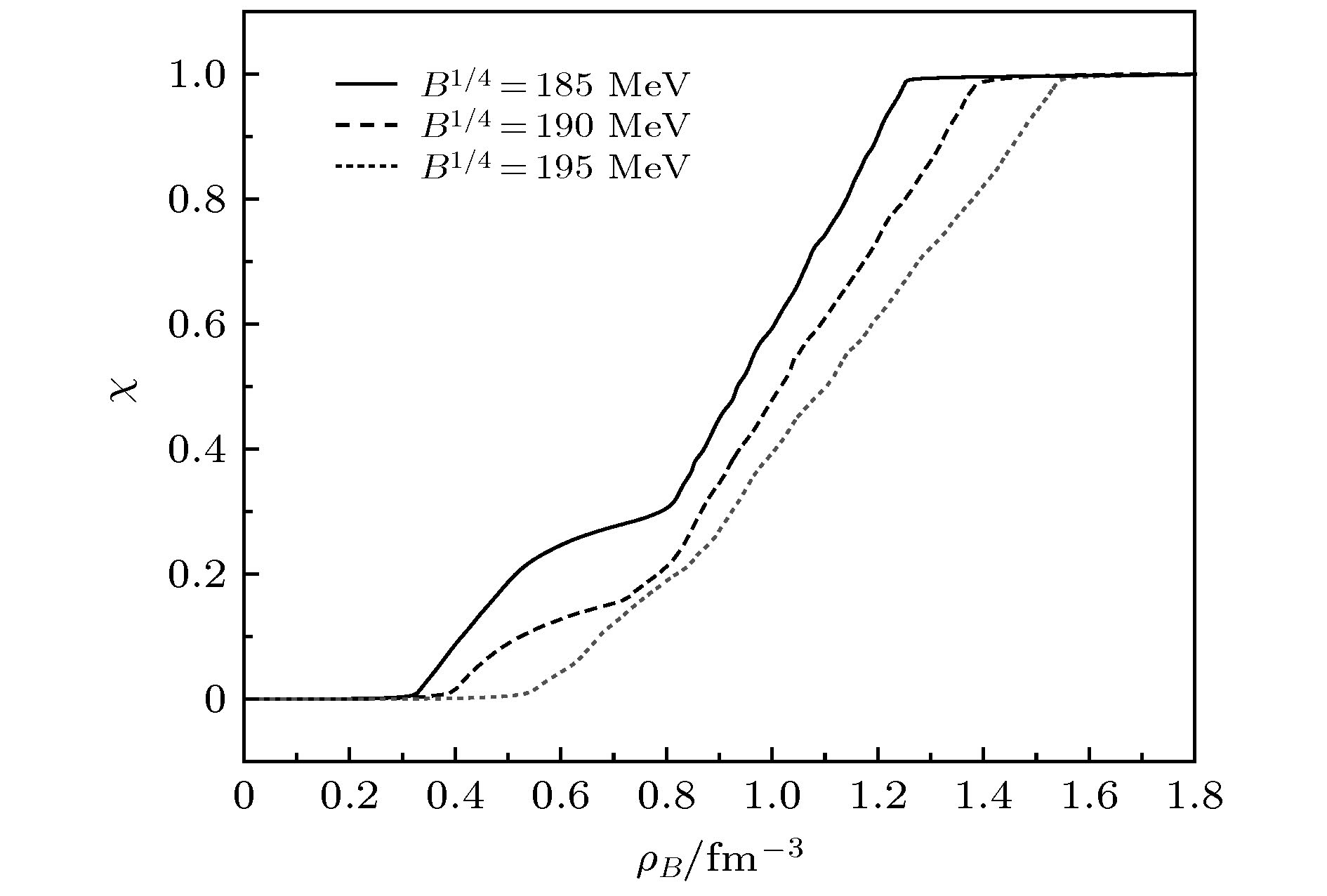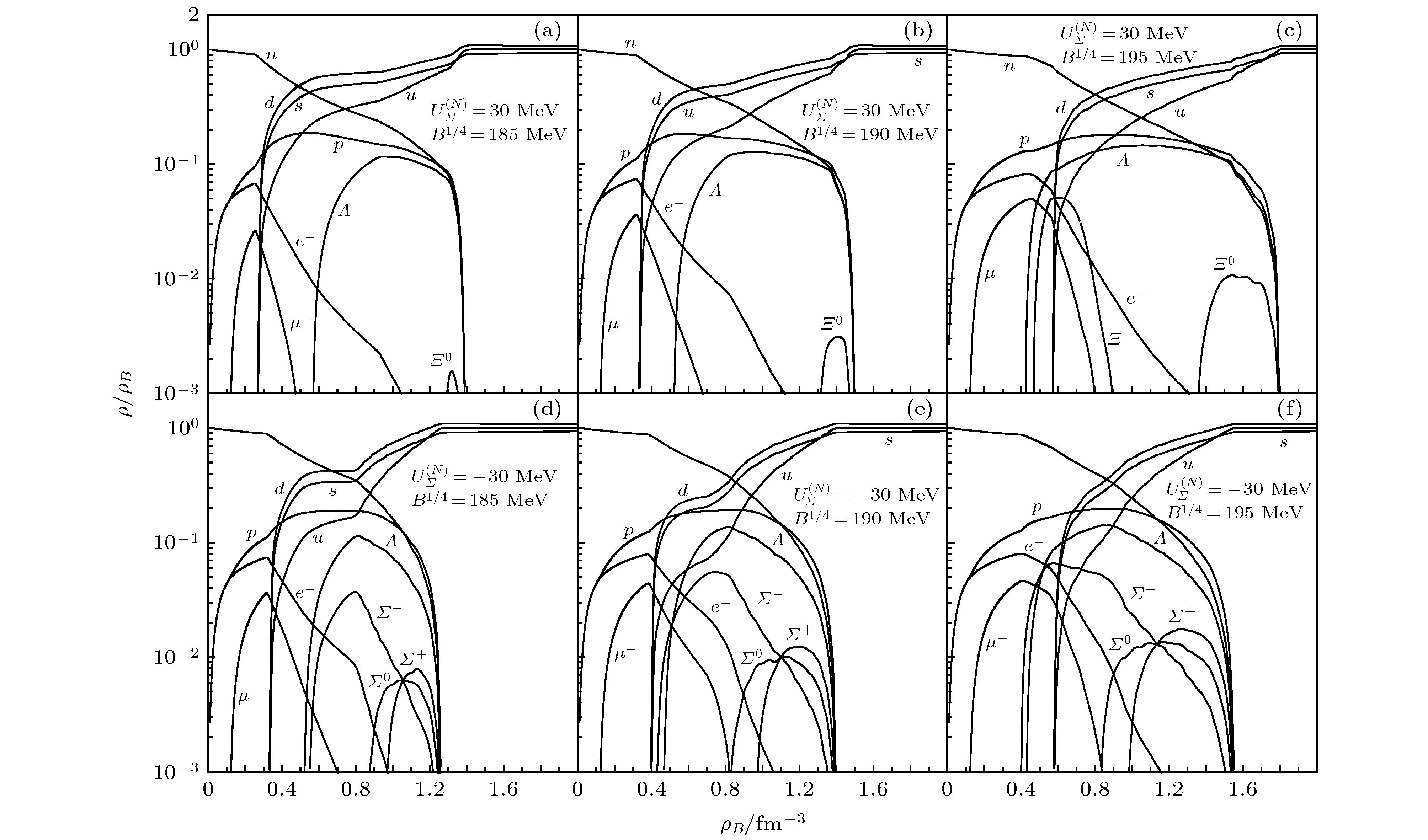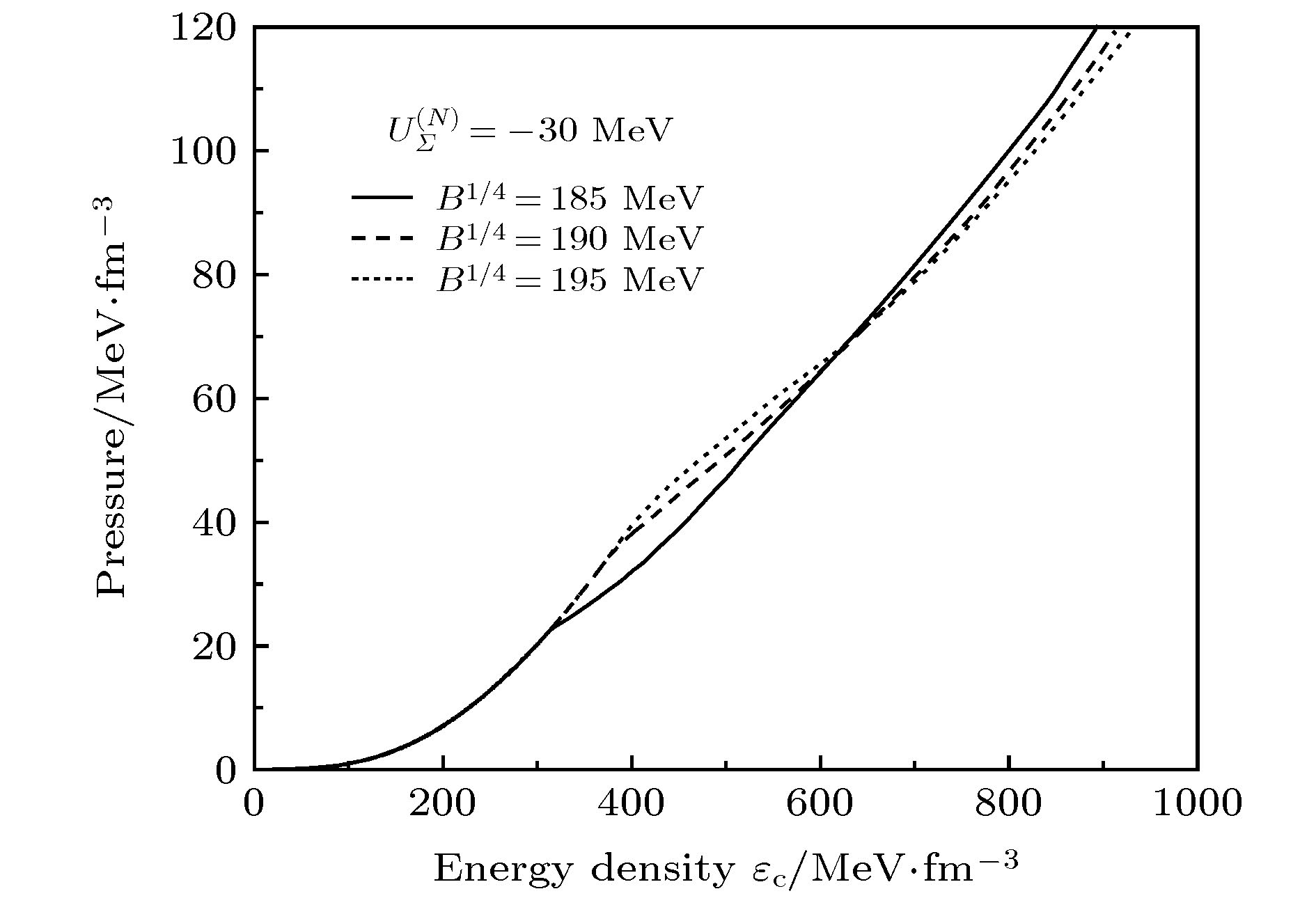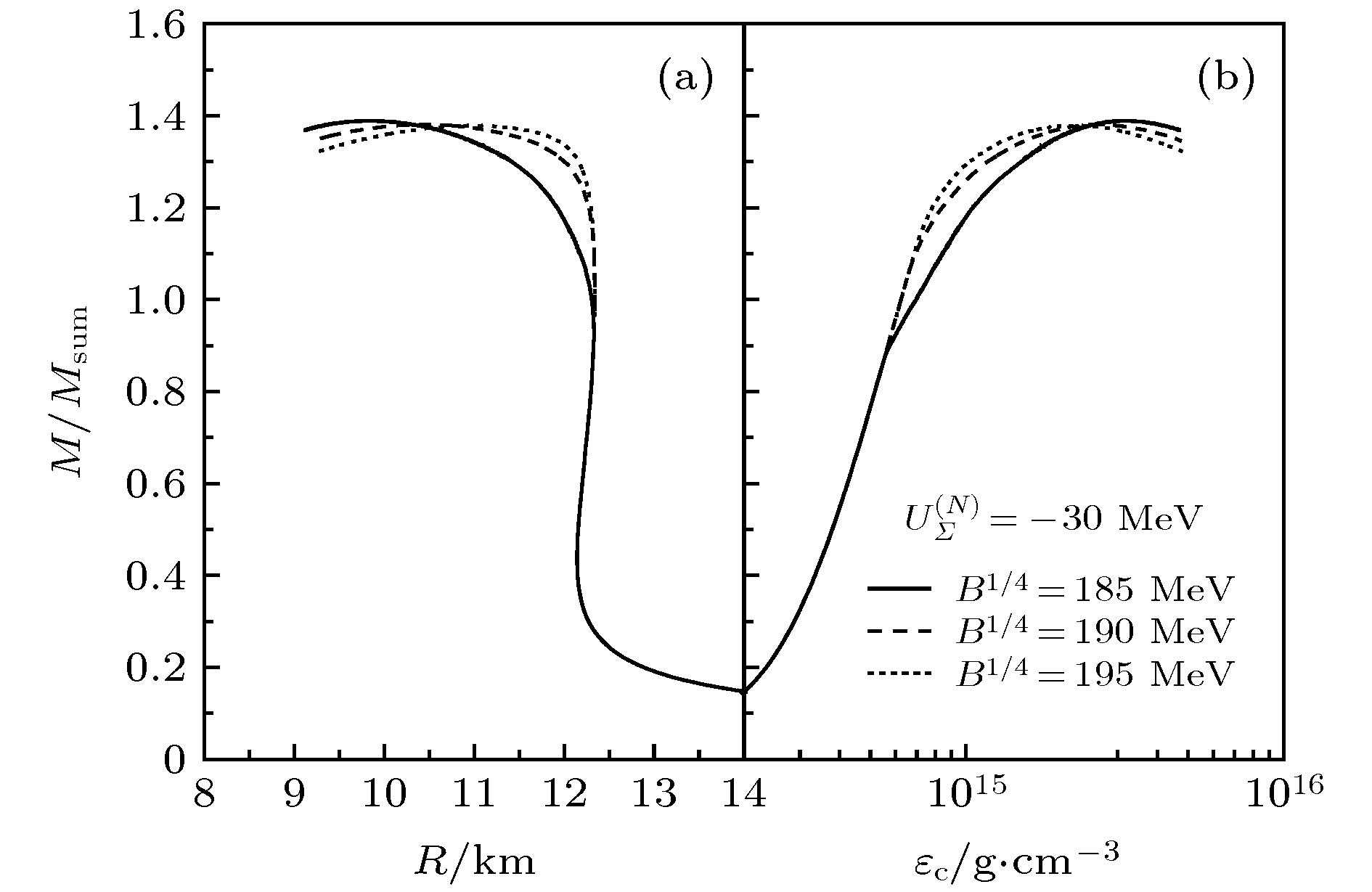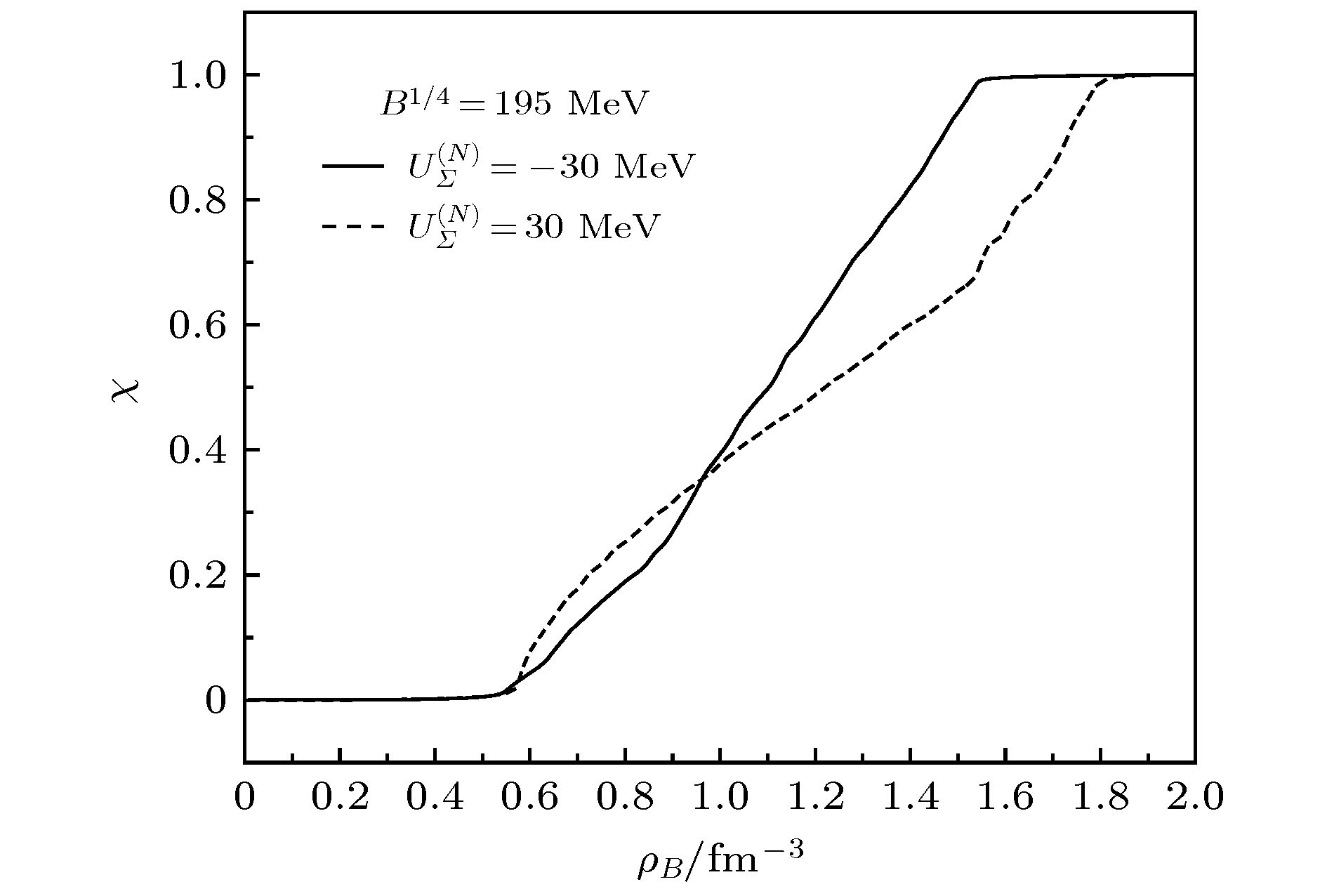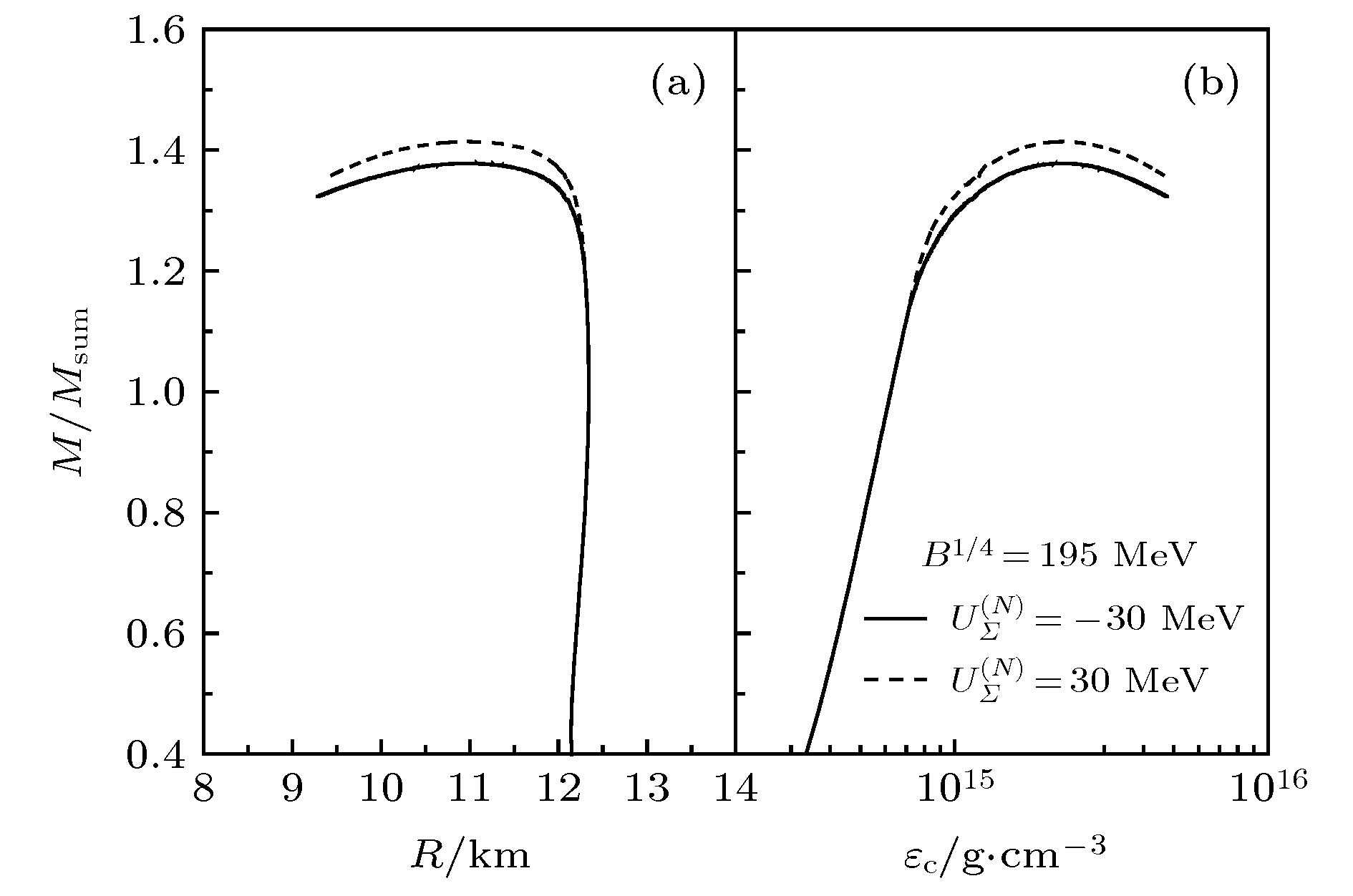-
高密度物质环境内可能存在多种相互竞争的粒子相. 利用包含ω2ρ2相互作用项的相对论平均场理论中FSUGold参数组描述强子相物质, 夸克质量密度相关的有效质量口袋模型描述夸克相物质, 再通过Gibbs相平衡条件构建强子-夸克混合相物质, 研究了处于β平衡的混合中子星性质. 计算口袋常数B对混合中子星性质的影响, 结果表明B对混合中子星内强子-夸克退禁闭相变始末点、粒子分布均有较大影响, 且相较于相变开始点, 相变结束点受B的影响会更加明显. 随着B的增大, 混合中子星物质状态方程变硬, 质量-半径关系曲线上升, 极限质量在1.3—1.4倍太阳质量(M☉)范围内, 半径在9—12 km之间. 此外, 还研究了吸引和排斥的Σ势对混合中子星性质的影响, 结果表明不同Σ势对混合中子星内的粒子种类影响较大, 且相较于Σ引力势, 混合中子星在Σ斥力势下拥有更大的极限质量. 计算得到吸引和排斥的Σ势下混合中子星的极限质量分别为1.38M☉和1.41M☉.Astronomical statistics shows that the mass of neutron star is of the order of the solar mass, but the radius is only about ten kilometers. Therefore, the neutron star is highly condensed and there may be a variety of competing material phases inside the compact star. Hadron-quark deconfinement phase transition that is poorly understood at high density can be studied by the matter properties of hybrid star. The hybrid star contains many kinds of material phases, which cannot be described uniformly by one theory. So, different material phases are described by different theories. The hadronic phase is described by the relativistic mean-field theory with parameter set FSUGold including ω2ρ2 interaction term, and the quark phase is described by an effective mass bag model in which the quark mass is density-dependent. The hadron-quark mixed phase is constructed by the Gibbs phase transition, and the properties of hybrid star in β equilibrium is studied in this model. It is found that the bag constant B has a great influence on the starting point and ending point of the hadron-quark deconfinement phase transition and the particle composition in the hybrid star. Comparing with the starting point of phase transition, the influence of B on the ending point of phase transition is very obvious. For the hybrid star, the equation of state of matter becomes stiffer at low density and softer at high density as B increases. The overall effect is that the slope of the mass-radius curve increases with B increasing. The calculated results show that the maximum mass of hybrid star is between 1.3 solar mass and 1.4 solar mass (M☉), and the radius is between 9 km and 12 km. In addition, the influence of attractive and repulsive Σ potential on the properties of hybrid stars are studied. The results show that the Σ potential has a great influence on the particle composition in the hybrid star. We also find that the repulsive Σ potential makes the hybrid star have a greater maximum mass then an attractive Σ potential. For the attractive Σ potential, the maximum mass of hybrid star is 1.38M☉, while for the repulsive Σ potential, the maximum mass of hybrid stars is 1.41M☉.
-
Keywords:
- dense nuclear matter /
- relativistic mean field /
- effective mass bag model /
- nuclear astrophysics
[1] Norsen T 2002 Phys. Rev. C 65 045805
 Google Scholar
Google Scholar
[2] Mintz B W, Fraga E S, Pagliara G, Schaffner-Bielich J 2010 Phys. Rev. D 81 123012
 Google Scholar
Google Scholar
[3] Mintz B W, Fraga E S, Schaffner-Bielich J, Pagliara G 2010 J. Phys. G Nucl. Part. Phys. 37 094066
 Google Scholar
Google Scholar
[4] Weissenborn S, Sagert I, Pagliara G, Hempel M, Schaffner-Bielich J 2011 Astrophys. J. 740 L14
 Google Scholar
Google Scholar
[5] Orsaria M, Rodrigues H, Weber F, Contrera G A 2013 Phys. Rev. D 87 023001
 Google Scholar
Google Scholar
[6] Schaffner-Bielich J, Dover C B, Gal A, Greiner C, Stöcker H 1993 Phys. Rev. Lett. 71 1328
 Google Scholar
Google Scholar
[7] Drago A, Pagliara G 2016 Eur. Phys. J. A 52 1
 Google Scholar
Google Scholar
[8] Torres J R, Gulminelli F, Menezes D P 2017 Phys. Rev. C 95 025201
 Google Scholar
Google Scholar
[9] Sedrakian A 2019 Phys. Rev. D 99 043011
 Google Scholar
Google Scholar
[10] Wu C, Qian W L, Ma Y G, Yang J F 2013 Int. J. Mod. Phys. E 22 1350026
 Google Scholar
Google Scholar
[11] Lim Y, Kwak K, Hyun C H, Lee C H 2014 Phys. Rev. C 89 055804
 Google Scholar
Google Scholar
[12] Mallick R, Schramm S, Dexheimer V, Bhattacharyya A 2015 Mon. Not. R. Astron. Soc. 449 1347
 Google Scholar
Google Scholar
[13] Kolomeitsev E E, Maslov K A, Voskresensky D N 2018 Nucl. Phys. A 970 291
 Google Scholar
Google Scholar
[14] Kiziltan B, Kottas A, De Yoreo M, Thorsett S E 2013 Astrophys. J. 778 66
 Google Scholar
Google Scholar
[15] Glendenning N K 2000 Phys. Rev. Lett. 85 1150
 Google Scholar
Google Scholar
[16] Harko T, Cheng K S, Tang P S 2004 Astrophys. J. 608 945
 Google Scholar
Google Scholar
[17] Li A, Peng G X, Lombardo U 2009 Chin. Phys. C 33 61
 Google Scholar
Google Scholar
[18] Alaverdyan A G, Alaverdyan G B, Chiladze A O 2010 Int. J. Mod. Phys. D 19 1557
 Google Scholar
Google Scholar
[19] Bhattacharyya A, Mishustin I N, Greiner W 2010 J. Phys. G Nucl. Part. Phys. 37 025201
 Google Scholar
Google Scholar
[20] Chen S W, Gao L, Peng G X 2012 Chin. Phys. C 36 947
 Google Scholar
Google Scholar
[21] Orsaria M, Rodrigues H, Weber F, Contrera G A 2014 Phys. Rev. C 89 015806
 Google Scholar
Google Scholar
[22] 陈建玲, 王辉, 贾焕玉, 马紫微, 李永宏, 谭俊 2019 物理学报 68 180401
 Google Scholar
Google Scholar
Cheng J L, Wang H, Jia H Y, Ma Z W, Li Y H, Tan J 2019 Acta Phys. Sin. 68 180401
 Google Scholar
Google Scholar
[23] Wu F, Wu C 2020 Eur. Phys. J. A 56 20
 Google Scholar
Google Scholar
[24] Duez M D, Liu Y T, Shapiro S L, Stephens B C 2004 Phys. Rev. D 69 104030
 Google Scholar
Google Scholar
[25] Roark J, Dexheimer V 2018 Phys. Rev. C 98 055805
 Google Scholar
Google Scholar
[26] Zdunik J L 2002 Astron. Astrophys. 394 641
 Google Scholar
Google Scholar
[27] Vartanyan Y L, Grigoryan A K, Sargsyan T R 2004 Astrophysics 47 189
 Google Scholar
Google Scholar
[28] Wu C, Su R K 2009 J. Phys. G Nucl. Part. Phys. 36 095101
 Google Scholar
Google Scholar
[29] Liu Y X, Gao D F, Guo H 2001 Nucl. Phys. A 695 353
 Google Scholar
Google Scholar
[30] Zhou E P, Zhou X, Li A 2018 Phys. Rev. D 97 083015
 Google Scholar
Google Scholar
[31] Li Z H, Schulze H J 2012 Phys. Rev. C 85 064002
 Google Scholar
Google Scholar
[32] Kohno M 2013 Phys. Rev. C 88 064005
 Google Scholar
Google Scholar
[33] Fukukawa K, Baldo M, Burgio G F, Lo Monaco L, Schulze H J 2015 Phys. Rev. C 92 065802
 Google Scholar
Google Scholar
[34] Hebeler K, Bogner S K, Furnstahl R J, Nogga A, Schwenk A 2011 Phys. Rev. C 83 031301
 Google Scholar
Google Scholar
[35] Coraggio L, Holt J W, Itaco N, Machleidt R, Marcucci L E, Sammarruca F 2014 Phys. Rev. C 89 044321
 Google Scholar
Google Scholar
[36] Drischler C, Hebeler K, Schwenk A 2016 Phys. Rev. C 93 054314
 Google Scholar
Google Scholar
[37] Xu R L, Wu C, Ren Z Z 2012 J. Phys. G Nucl. Part. Phys. 39 085107
 Google Scholar
Google Scholar
[38] 高朋林, 郑皓, 孙光爱 2019 物理学报 68 181102
 Google Scholar
Google Scholar
Gao P L, Zheng H, Sun G A 2019 Acta Phys. Sin. 68 181102
 Google Scholar
Google Scholar
[39] Menezes D P, Providência C 2003 Phys. Rev. C 68 035804
 Google Scholar
Google Scholar
[40] Bao T, Liu G Z, Zhu M F 2009 Chin. Phys. C 33 340
 Google Scholar
Google Scholar
[41] Bao T, Li G Q, Wang Z C, Yang X Q, Liu G Z 2011 Chin. Phys. C 35 539
 Google Scholar
Google Scholar
[42] Baldo M, Burgio G F, Castorina P, Plumari S, Zappalà D 2007 Phys. Rev. C 75 035804
 Google Scholar
Google Scholar
[43] Peng G X, Li A, Lombardo U 2008 Phys. Rev. C 77 065807
 Google Scholar
Google Scholar
[44] Wu C, Ren Z Z 2011 Phys. Rev. C 83 025805
 Google Scholar
Google Scholar
[45] Glendenning N K 1982 Phys. Lett. B 114 392
 Google Scholar
Google Scholar
[46] Todd-Rutel B G, Piekarewicz J 2005 Phys. Rev. Lett. 95 122501
 Google Scholar
Google Scholar
[47] Millener D J, Dover C B, Gal A 1988 Phys. Rev. C 38 2700
 Google Scholar
Google Scholar
[48] Schaffner-Bielich J, Gal A 2000 Phys. Rev. C 62 034311
 Google Scholar
Google Scholar
[49] Schaffner-Bielich J, Dover C B, Gal A, Greiner C, Millener D J, Stöcker H 1994 Ann. Phys. (N.Y). 235 35
 Google Scholar
Google Scholar
[50] Schertler K, Greiner C, Thoma M H 1997 J. Phys. G Nucl. Part. Phys. 23 2051
 Google Scholar
Google Scholar
[51] Schertler K, Greiner C, Schaffner-Bielich J, Thoma M H 2000 Nucl. Phys. A 677 463
 Google Scholar
Google Scholar
[52] Bao T, Liu G Z, Zhao E G, Zhu M F 2008 Eur. Phys. J. A 38 287
 Google Scholar
Google Scholar
-
图 1 强子相(划线)、混合相(实线)、夸克相(点线)中, 每核子能量与物质密度的关系(a)以及压强与物质密度的关系(b), 取
$ {{B}}^{{1/4}} $ = 195 MeV,$U_\varSigma^{(N)} $ = –30 MeVFig. 1. Relationships of each nucleon (a) and pressure (b) with matter density in hadron phase (dashed line), mixed phase (solid line) and quark phase (dotted line), respectively, with
$ {{B}}^{{1/4}} $ = 195 MeV,$U_\varSigma^{(N)} $ = –30 MeV.图 2
$U_\varSigma^{(N)} $ = –30 MeV下$ {{B}}^{{1/4}} $ = 185 MeV (实线)、190 MeV (划线)、195 MeV (点线)时夸克相在混合星内的占比χFig. 2. Proportion of quark phase χ in hybrid stars when
$ {{B}}^{{1/4}} $ taking 185 MeV (solid line), 190 MeV (dashed line) and 195 MeV (dotted line), respectively, with$U_\varSigma^{(N)} $ = –30 MeV.图 3 混合星粒子分布图(
$ {{B}}^{{1/4}} $ 分别取185, 190, 195 MeV) (a), (b), (c)$U_\varSigma^{(N)} $ = 30 MeV; (d), (e), (f)$U_\varSigma^{(N)} $ = –30 MeVFig. 3. Particle composition in the hybrid star: (a), (b), (c)
$U_\varSigma^{(N)} $ = 30 MeV; (d), (e), (f)$U_\varSigma^{(N)} $ = –30 MeV.$ {{B}}^{{1/4}} $ taking 185, 190, and 195 MeV.图 6
$ {{B}}^{{1/4}} $ = 195 MeV下混合星内夸克相比份χ分布, 其中实线表示$U_\varSigma^{(N)} $ = –30 MeV的情况; 虚线表示$U_\varSigma^{(N)} $ = 30 MeV的情况Fig. 6. Proportion of quark phase χ in hybrid stars when
$U_\varSigma^{(N)} $ taking –30 MeV (solid line) and 30 MeV (dashed line) at$ {{B}}^{{1/4}} $ = 195 MeV, respectively.图 7
$ {{B}}^{{1/4}} $ = 195 MeV下混合星的质量-半径关系(a)和质量-能量密度关系(b), 其中实线表示$U_\varSigma^{(N)} $ = –30 MeV, 虚线表示$U_\varSigma^{(N)} $ = 30 MeVFig. 7. Mass-radius (a) and mass-energy density (b) curves of hybrid stars, respectively, with
$U_\varSigma^{(N)} $ taking –30 MeV (solid line) and 30 MeV (dashed line) at$ {{B}}^{{1/4}} $ = 195 MeV. -
[1] Norsen T 2002 Phys. Rev. C 65 045805
 Google Scholar
Google Scholar
[2] Mintz B W, Fraga E S, Pagliara G, Schaffner-Bielich J 2010 Phys. Rev. D 81 123012
 Google Scholar
Google Scholar
[3] Mintz B W, Fraga E S, Schaffner-Bielich J, Pagliara G 2010 J. Phys. G Nucl. Part. Phys. 37 094066
 Google Scholar
Google Scholar
[4] Weissenborn S, Sagert I, Pagliara G, Hempel M, Schaffner-Bielich J 2011 Astrophys. J. 740 L14
 Google Scholar
Google Scholar
[5] Orsaria M, Rodrigues H, Weber F, Contrera G A 2013 Phys. Rev. D 87 023001
 Google Scholar
Google Scholar
[6] Schaffner-Bielich J, Dover C B, Gal A, Greiner C, Stöcker H 1993 Phys. Rev. Lett. 71 1328
 Google Scholar
Google Scholar
[7] Drago A, Pagliara G 2016 Eur. Phys. J. A 52 1
 Google Scholar
Google Scholar
[8] Torres J R, Gulminelli F, Menezes D P 2017 Phys. Rev. C 95 025201
 Google Scholar
Google Scholar
[9] Sedrakian A 2019 Phys. Rev. D 99 043011
 Google Scholar
Google Scholar
[10] Wu C, Qian W L, Ma Y G, Yang J F 2013 Int. J. Mod. Phys. E 22 1350026
 Google Scholar
Google Scholar
[11] Lim Y, Kwak K, Hyun C H, Lee C H 2014 Phys. Rev. C 89 055804
 Google Scholar
Google Scholar
[12] Mallick R, Schramm S, Dexheimer V, Bhattacharyya A 2015 Mon. Not. R. Astron. Soc. 449 1347
 Google Scholar
Google Scholar
[13] Kolomeitsev E E, Maslov K A, Voskresensky D N 2018 Nucl. Phys. A 970 291
 Google Scholar
Google Scholar
[14] Kiziltan B, Kottas A, De Yoreo M, Thorsett S E 2013 Astrophys. J. 778 66
 Google Scholar
Google Scholar
[15] Glendenning N K 2000 Phys. Rev. Lett. 85 1150
 Google Scholar
Google Scholar
[16] Harko T, Cheng K S, Tang P S 2004 Astrophys. J. 608 945
 Google Scholar
Google Scholar
[17] Li A, Peng G X, Lombardo U 2009 Chin. Phys. C 33 61
 Google Scholar
Google Scholar
[18] Alaverdyan A G, Alaverdyan G B, Chiladze A O 2010 Int. J. Mod. Phys. D 19 1557
 Google Scholar
Google Scholar
[19] Bhattacharyya A, Mishustin I N, Greiner W 2010 J. Phys. G Nucl. Part. Phys. 37 025201
 Google Scholar
Google Scholar
[20] Chen S W, Gao L, Peng G X 2012 Chin. Phys. C 36 947
 Google Scholar
Google Scholar
[21] Orsaria M, Rodrigues H, Weber F, Contrera G A 2014 Phys. Rev. C 89 015806
 Google Scholar
Google Scholar
[22] 陈建玲, 王辉, 贾焕玉, 马紫微, 李永宏, 谭俊 2019 物理学报 68 180401
 Google Scholar
Google Scholar
Cheng J L, Wang H, Jia H Y, Ma Z W, Li Y H, Tan J 2019 Acta Phys. Sin. 68 180401
 Google Scholar
Google Scholar
[23] Wu F, Wu C 2020 Eur. Phys. J. A 56 20
 Google Scholar
Google Scholar
[24] Duez M D, Liu Y T, Shapiro S L, Stephens B C 2004 Phys. Rev. D 69 104030
 Google Scholar
Google Scholar
[25] Roark J, Dexheimer V 2018 Phys. Rev. C 98 055805
 Google Scholar
Google Scholar
[26] Zdunik J L 2002 Astron. Astrophys. 394 641
 Google Scholar
Google Scholar
[27] Vartanyan Y L, Grigoryan A K, Sargsyan T R 2004 Astrophysics 47 189
 Google Scholar
Google Scholar
[28] Wu C, Su R K 2009 J. Phys. G Nucl. Part. Phys. 36 095101
 Google Scholar
Google Scholar
[29] Liu Y X, Gao D F, Guo H 2001 Nucl. Phys. A 695 353
 Google Scholar
Google Scholar
[30] Zhou E P, Zhou X, Li A 2018 Phys. Rev. D 97 083015
 Google Scholar
Google Scholar
[31] Li Z H, Schulze H J 2012 Phys. Rev. C 85 064002
 Google Scholar
Google Scholar
[32] Kohno M 2013 Phys. Rev. C 88 064005
 Google Scholar
Google Scholar
[33] Fukukawa K, Baldo M, Burgio G F, Lo Monaco L, Schulze H J 2015 Phys. Rev. C 92 065802
 Google Scholar
Google Scholar
[34] Hebeler K, Bogner S K, Furnstahl R J, Nogga A, Schwenk A 2011 Phys. Rev. C 83 031301
 Google Scholar
Google Scholar
[35] Coraggio L, Holt J W, Itaco N, Machleidt R, Marcucci L E, Sammarruca F 2014 Phys. Rev. C 89 044321
 Google Scholar
Google Scholar
[36] Drischler C, Hebeler K, Schwenk A 2016 Phys. Rev. C 93 054314
 Google Scholar
Google Scholar
[37] Xu R L, Wu C, Ren Z Z 2012 J. Phys. G Nucl. Part. Phys. 39 085107
 Google Scholar
Google Scholar
[38] 高朋林, 郑皓, 孙光爱 2019 物理学报 68 181102
 Google Scholar
Google Scholar
Gao P L, Zheng H, Sun G A 2019 Acta Phys. Sin. 68 181102
 Google Scholar
Google Scholar
[39] Menezes D P, Providência C 2003 Phys. Rev. C 68 035804
 Google Scholar
Google Scholar
[40] Bao T, Liu G Z, Zhu M F 2009 Chin. Phys. C 33 340
 Google Scholar
Google Scholar
[41] Bao T, Li G Q, Wang Z C, Yang X Q, Liu G Z 2011 Chin. Phys. C 35 539
 Google Scholar
Google Scholar
[42] Baldo M, Burgio G F, Castorina P, Plumari S, Zappalà D 2007 Phys. Rev. C 75 035804
 Google Scholar
Google Scholar
[43] Peng G X, Li A, Lombardo U 2008 Phys. Rev. C 77 065807
 Google Scholar
Google Scholar
[44] Wu C, Ren Z Z 2011 Phys. Rev. C 83 025805
 Google Scholar
Google Scholar
[45] Glendenning N K 1982 Phys. Lett. B 114 392
 Google Scholar
Google Scholar
[46] Todd-Rutel B G, Piekarewicz J 2005 Phys. Rev. Lett. 95 122501
 Google Scholar
Google Scholar
[47] Millener D J, Dover C B, Gal A 1988 Phys. Rev. C 38 2700
 Google Scholar
Google Scholar
[48] Schaffner-Bielich J, Gal A 2000 Phys. Rev. C 62 034311
 Google Scholar
Google Scholar
[49] Schaffner-Bielich J, Dover C B, Gal A, Greiner C, Millener D J, Stöcker H 1994 Ann. Phys. (N.Y). 235 35
 Google Scholar
Google Scholar
[50] Schertler K, Greiner C, Thoma M H 1997 J. Phys. G Nucl. Part. Phys. 23 2051
 Google Scholar
Google Scholar
[51] Schertler K, Greiner C, Schaffner-Bielich J, Thoma M H 2000 Nucl. Phys. A 677 463
 Google Scholar
Google Scholar
[52] Bao T, Liu G Z, Zhao E G, Zhu M F 2008 Eur. Phys. J. A 38 287
 Google Scholar
Google Scholar
计量
- 文章访问数: 8479
- PDF下载量: 92
- 被引次数: 0


















 下载:
下载:
